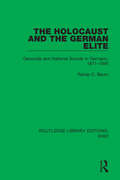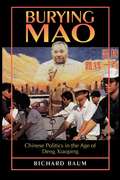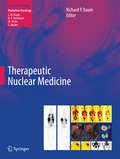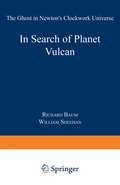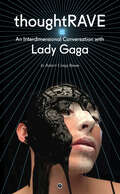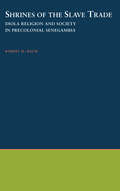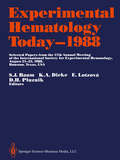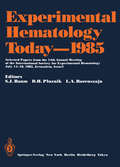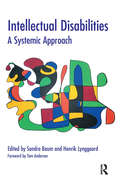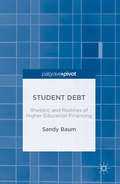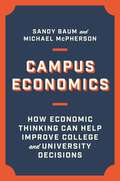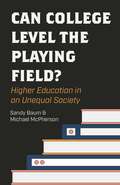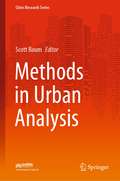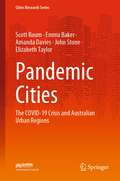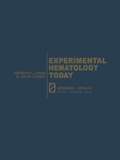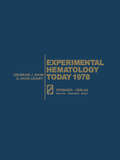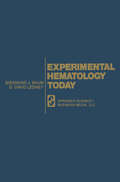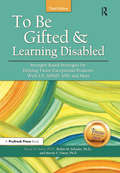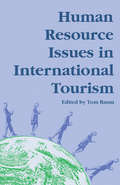- Table View
- List View
The Holocaust and the German Elite: Genocide and National Suicide in Germany, 1871–1945 (Routledge Library Editions: WW2 #13)
by Rainer C. BaumThis book, first published in 1981, is a study of the social and political sources of amoral political rule in modern times. Only a moral indifference unparalleled in history made the Holocaust possible, and by linking the German imperial ambitions to the meaningless suffering and death in the concentration camps, the true significance of the Holocaust is revealed in all its horror. Understanding this requires an understanding of the social forces that produced a national amorality among Germany’s elites. The author suggests three contributive causes: a marked ambiguity among Germans in their attitude towards social values; the development of a cadre characterized by status insecurity; and an inability to resolve internal conflict.
The Holocaust and the German Elite: Genocide and National Suicide in Germany, 1871–1945 (Routledge Library Editions: WW2 #13)
by Rainer C. BaumThis book, first published in 1981, is a study of the social and political sources of amoral political rule in modern times. Only a moral indifference unparalleled in history made the Holocaust possible, and by linking the German imperial ambitions to the meaningless suffering and death in the concentration camps, the true significance of the Holocaust is revealed in all its horror. Understanding this requires an understanding of the social forces that produced a national amorality among Germany’s elites. The author suggests three contributive causes: a marked ambiguity among Germans in their attitude towards social values; the development of a cadre characterized by status insecurity; and an inability to resolve internal conflict.
Burying Mao: Chinese Politics in the Age of Deng Xiaoping (PDF)
by Richard BaumFor almost two decades after Mao Zedong's death, an epic, no-holds-barred contest was waged in China between orthodox Marxists and reformers. With Deng Xiaoping's strong support, the reformers ultimately won; but they--and China--paid a heavy price. Here, Richard Baum provides a lively, comprehensive guide to the intricate theater of post-Mao Chinese politics. He tells the intriguing story of an escalating intergenerational clash of ideas and values between the aging revolutionaries of the Maoist era and their younger, more pragmatic successors. Baum deftly analyzes the anatomy of the reformers' ultimate victory in his brilliant reconstruction of the twists and turns of the reform process.
Burying Mao: Chinese Politics in the Age of Deng Xiaoping - Updated Edition
by Richard BaumFor almost two decades after Mao Zedong's death, an epic, no-holds-barred contest was waged in China between orthodox Marxists and reformers. With Deng Xiaoping's strong support, the reformers ultimately won; but they--and China--paid a heavy price. Here, Richard Baum provides a lively, comprehensive guide to the intricate theater of post-Mao Chinese politics. He tells the intriguing story of an escalating intergenerational clash of ideas and values between the aging revolutionaries of the Maoist era and their younger, more pragmatic successors. Baum deftly analyzes the anatomy of the reformers' ultimate victory in his brilliant reconstruction of the twists and turns of the reform process.
Therapeutic Nuclear Medicine (Medical Radiology)
by Richard P. BaumThe recent revolution in molecular biology offers exciting new opportunities for targeted radionuclide therapy. This up-to-date, comprehensive book, written by world-renowned experts, discusses the basic principles of radionuclide therapy, explores in detail the available treatments, explains the regulatory requirements, and examines likely future developments. The full range of clinical applications is considered, including thyroid cancer, hematological malignancies, brain tumors, liver cancer, bone and joint disease, and neuroendocrine tumors. The combination of theoretical background and practical information will provide the reader with all the knowledge required to administer radionuclide therapy safely and effectively in the individual patient. Careful attention is also paid to the role of the therapeutic nuclear physician in coordinating a diverse multidisciplinary team, which is central to the safe provision of treatment.
In Search of Planet Vulcan: The Ghost in Newton’s Clockwork Universe
by Richard P. Baum William SheehanThoughtrave: An Interdimensional Conversation with Lady Gaga
by Robert Craig BaumThoughtrave is the immediate and most detailed archive of Lady Gaga’s emotional, intellectual, philosophical, and spiritual evolution, a reclaiming of her art (and humanity) from within the center of her celebrity during one of the most difficult transitions of her career: Summer 2013–Fall 2014. I don’t like being used to make money. I feel sad when I am overworked and that I just become a money making machine and that my passion and my creativity take a backseat. That makes me unhappy. So, what did I do? I started to say no. Not doing that. I don’t want to do that. I’m not taking that picture. Not going to that event. Not standing by that because that’s not what I stand for. Thoughtrave marks perhaps the most important (and unconditional, unpublished, unencumbered) insights into the music industry, as well as into the personal battles that accompanied her transition from Stefani to Gaga. “It’s one of those rare moments in life when you ask a question of someone you’ve admired for many years and receive the most honest of answers leading both people into a relationship that was and remains one of the most important of my life,” says Baum, a professor, producer, composer, writer, editor, and activist for adjunct professors. As Baum explains to Stefani in one of the many interviews published here for the first time, It’s uncanny for me to look back at 2008–2011 — when I was intensely meditating on the problem “Why is there any being at all?” — to find evidence of your intervention here with me…to find you, back then…before I knew you. It was almost as if I was playing the Bruce Willis character in Twelve Monkeys, overshooting my mark in time/space, aiming for this particular conversation but speaking through Ereignis (life gives) to a moment I (and many others) call “headphones on.”
Shrines of the Slave Trade: Diola Religion and Society in Precolonial Senegambia
by Robert M. BaumIn this groundbreaking work, Robert Baum seeks to reconstruct the religious and social history of the Diola communities in southern Senegal during the precolonial era, when the Atlantic slave trade was at its height. Baum shows that Diola community leaders used a complex of religious shrines and priesthoods to regulate and contain the influence of the slave trade. He demonstrates how this close involvement with the traders significantly changed Diola religious life.
Experimental Hematology Today—1988: Selected Papers from the 17th Annual Meeting of the International Society for Experimental Hematology August 21–25, 1988, Houston, Texas, USA (Experimental Hematology Today #1988)
by S. J. BaumExperimental Hematology Today - 1988 presents the latest results of research reflecting the diverse interests of basic and clinical hematologists. The major areas explored are hematopoietic regulation by cytokines; hematopoietic cellular growth regulation, with emphasis on the interaction of stromal with hematopoietic stem and progenitor cells; granulopoietic regulators; gene transfers into hematopoietic progenitor cells; leukemogenesis; and bone marrow transplantation. All chapters report on research or clinical findings of the past year.
Experimental Hematology Today—1985: Selected Papers from the 14th Annual Meeting of the International Society for Experimental Hematology, July 14–18, 1985, Jerusalem, Israel (pdf) (Experimental Hematology Today #1985)
by S. J. Baum D. H. Pluznik L. A. Rosenszajn Ramat-GanIntellectual Disabilities: A Systemic Approach (The Systemic Thinking and Practice Series)
by Sandra Baum Henrik LynggaardThe application of systemic ideas and principles in working with people with intellectual disabilities, their families and their service systems, has grown over the last decade in the UK. This book, for the first time, brings together the writings of a group of practitioners who have been using this approach in their clinical practice. It is hoped it will inspire others to try out different ways of working with people with intellectual disabilities and their wider systems, so that they can have the choice of a wide range of therapeutic approaches. It is also hoped that systemic practitioners who are unfamiliar with this client group might give consideration to extend their practice to also work with people with intellectual disabilities.
Intellectual Disabilities: A Systemic Approach (The Systemic Thinking and Practice Series)
by Sandra Baum Henrik LynggaardThe application of systemic ideas and principles in working with people with intellectual disabilities, their families and their service systems, has grown over the last decade in the UK. This book, for the first time, brings together the writings of a group of practitioners who have been using this approach in their clinical practice. It is hoped it will inspire others to try out different ways of working with people with intellectual disabilities and their wider systems, so that they can have the choice of a wide range of therapeutic approaches. It is also hoped that systemic practitioners who are unfamiliar with this client group might give consideration to extend their practice to also work with people with intellectual disabilities.
Student Debt: Rhetoric and Realities of Higher Education Financing
by Sandy BaumThis book analyzes reliable evidence to tell the true story of student debt in America. One of the nation’s foremost experts on college finance, Sandy Baum exposes how misleading the widely accepted narrative on student debt is. Baum combines data, research, and analysis to show how the current discourse obscures serious problems, risks misdirecting taxpayer dollars, and could deprive too many Americans of the educational opportunities they deserve. This book and its policy recommendations provide the basis for a new and more constructive national agenda to make paying for college more manageable.
Campus Economics: How Economic Thinking Can Help Improve College and University Decisions
by Sandy Baum Michael McPhersonAn invaluable primer on the role economic reasoning plays in campus debate and decision makingCampus Economics provides college and university administrators, trustees, and faculty with an essential understanding of how college finances actually work. Sandy Baum and Michael McPherson explain the concepts needed to analyze the pros, the cons, and the trade-offs of difficult decisions, and offer a common language for discussing the many challenges confronting institutions of higher learning today, from COVID-19 to funding cuts and declining enrollments.Emphasizing the unique characteristics of the academic enterprise and the primacy of the institutional mission, Baum and McPherson use economic concepts such as opportunity cost and decisions at the margin to facilitate conversations about how best to ensure an institution’s ongoing success. The problems facing higher education are more urgent than ever before, but the underlying issues are the same in good times and bad. Baum and McPherson give nontechnical, user-friendly guidance for navigating all kinds of economic conditions and draw on real-world examples of campus issues to illustrate both institutional constraints and untapped opportunities.Campus Economics helps faculty, administrators, trustees, and government policymakers engage in constructive dialogue that can lead to decisions that align finite resources with the pursuit of the institutional mission.
Campus Economics: How Economic Thinking Can Help Improve College and University Decisions
by Sandy Baum Michael McPhersonAn invaluable primer on the role economic reasoning plays in campus debate and decision makingCampus Economics provides college and university administrators, trustees, and faculty with an essential understanding of how college finances actually work. Sandy Baum and Michael McPherson explain the concepts needed to analyze the pros, the cons, and the trade-offs of difficult decisions, and offer a common language for discussing the many challenges confronting institutions of higher learning today, from COVID-19 to funding cuts and declining enrollments.Emphasizing the unique characteristics of the academic enterprise and the primacy of the institutional mission, Baum and McPherson use economic concepts such as opportunity cost and decisions at the margin to facilitate conversations about how best to ensure an institution’s ongoing success. The problems facing higher education are more urgent than ever before, but the underlying issues are the same in good times and bad. Baum and McPherson give nontechnical, user-friendly guidance for navigating all kinds of economic conditions and draw on real-world examples of campus issues to illustrate both institutional constraints and untapped opportunities.Campus Economics helps faculty, administrators, trustees, and government policymakers engage in constructive dialogue that can lead to decisions that align finite resources with the pursuit of the institutional mission.
Can College Level the Playing Field?: Higher Education in an Unequal Society
by Sandy Baum Michael McPhersonWhy higher education is not a silver bullet for eradicating economic inequality and social injusticeWe often think that a college degree will open doors to opportunity regardless of one’s background or upbringing. In this eye-opening book, two of today’s leading economists argue that higher education alone cannot overcome the lasting effects of inequality that continue to plague us, and offer sensible solutions for building a more just and equitable society.Sandy Baum and Michael McPherson document the starkly different educational and social environments in which children of different races and economic backgrounds grow up, and explain why social equity requires sustained efforts to provide the broadest possible access to high-quality early childhood and K–12 education. They dismiss panaceas like eliminating college tuition and replacing the classroom experience with online education, revealing why they fail to provide better education for those who need it most, and discuss how wages in our dysfunctional labor market are sharply skewed toward the highly educated. Baum and McPherson argue that greater investment in the postsecondary institutions that educate most low-income and marginalized students will have a bigger impact than just getting more students from these backgrounds into the most prestigious colleges and universities.While the need for reform extends far beyond our colleges and universities, there is much that both academic and government leaders can do to mitigate the worst consequences of America’s deeply seated inequalities. This book shows how we can address the root causes of social injustice and level the playing field for students and families before, during, and after college.
Can College Level the Playing Field?: Higher Education in an Unequal Society
by Sandy Baum Michael McPhersonWhy higher education is not a silver bullet for eradicating economic inequality and social injusticeWe often think that a college degree will open doors to opportunity regardless of one’s background or upbringing. In this eye-opening book, two of today’s leading economists argue that higher education alone cannot overcome the lasting effects of inequality that continue to plague us, and offer sensible solutions for building a more just and equitable society.Sandy Baum and Michael McPherson document the starkly different educational and social environments in which children of different races and economic backgrounds grow up, and explain why social equity requires sustained efforts to provide the broadest possible access to high-quality early childhood and K–12 education. They dismiss panaceas like eliminating college tuition and replacing the classroom experience with online education, revealing why they fail to provide better education for those who need it most, and discuss how wages in our dysfunctional labor market are sharply skewed toward the highly educated. Baum and McPherson argue that greater investment in the postsecondary institutions that educate most low-income and marginalized students will have a bigger impact than just getting more students from these backgrounds into the most prestigious colleges and universities.While the need for reform extends far beyond our colleges and universities, there is much that both academic and government leaders can do to mitigate the worst consequences of America’s deeply seated inequalities. This book shows how we can address the root causes of social injustice and level the playing field for students and families before, during, and after college.
Methods in Urban Analysis (Cities Research Series)
by Scott BaumThis book highlights major quantitative and qualitative methods and approaches used in the field of urban analysis. The respective chapters cover the background and relevance of various approaches to urban studies and offer guidance on implementing specific methodologies. Each chapter also provides links to real-world examples. The book is unique in its focus on Australian examples and subject matter, presented by recognized experts in the field.
Pandemic Cities: The COVID-19 Crisis and Australian Urban Regions (Cities Research Series)
by Scott Baum Emma Baker Amanda Davies John Stone Elizabeth TaylorThis book highlights the impact of the COVID-19 pandemic on cities. The COVID-19 pandemic and the associated economic and social impacts have been felt around the world. In large cities and other urban areas, the pandemic has highlighted a number of issues from pressures on urban labour and housing markets, shifts in demographic processes including migration and mobility, changes in urban travel patterns and pressures on contemporary planning and governance processes. Despite Australia’s relatively mild COVID exposure, Australian cities and large urban areas have not been immune to these issues. The economic shutdown of the country in the early stages of the pandemic, the sporadic border closures between states, the effective closure of international borders and the imposition of widespread public health orders that have required significant behavioural change across the population have all changed our cities in some and the way we live and work in them in some way. Some of the challenges have reflected long-standing problems including intrenched inequality in labour markets and housing markets, others such as the impact on commuting patterns and patterns of migration have emerged largely during the pandemic. This book, co-authored by experts in their field, outlines some of the major issues facing Australian cities and urban areas as a result of the pandemic and sets a course for future of the cities we live in.
Experimental Hematology Today: 5th Annual Meeting, August 17-20, 1976, Washington D.C., USA (Experimental Hematology Today #1977)
by Siegmund J. Baum G. David LedneyExperimental Hematology Today 1978 (Experimental Hematology Today #1978)
by Siegmund J. Baum G. David LedneyExperimental Hematology Today
by Siegmund J. Baum G. David Ledney International Society for Experimental HematologyTo Be Gifted and Learning Disabled: Strength-Based Strategies for Helping Twice-Exceptional Students With LD, ADHD, ASD, and More
by Susan M. Baum Robin M. Schader Steven V. OwenTo Be Gifted and Learning Disabled is one of the most popular resources available on identifying and meeting the needs of twice-exceptional students. This updated third edition provides a comprehensive look at the complex world of students with remarkable gifts, talents, and interests, who simultaneously face learning, attention, or social challenges from LD, ADHD, ASD, and other disorders. Through case studies and years of research, the authors present a rationale for using a strength-based, talent-focused approach to meeting the needs of this special population. From a thorough description of twice-exceptionality and the unique learning patterns of these students, to strategies for identification, comprehensive programming, talent development, and instructional strategies, this book explores the distinguishing strengths (yellows) and complex challenges (blues) that these students face. In painting, green is a mix of yellows and blues. Because of their individual characteristics, twice-exceptional students come in a remarkable range of greens. 2018 NAGC Book of the Year Award Winner
To Be Gifted and Learning Disabled: Strength-Based Strategies for Helping Twice-Exceptional Students With LD, ADHD, ASD, and More
by Susan M. Baum Robin M. Schader Steven V. OwenTo Be Gifted and Learning Disabled is one of the most popular resources available on identifying and meeting the needs of twice-exceptional students. This updated third edition provides a comprehensive look at the complex world of students with remarkable gifts, talents, and interests, who simultaneously face learning, attention, or social challenges from LD, ADHD, ASD, and other disorders. Through case studies and years of research, the authors present a rationale for using a strength-based, talent-focused approach to meeting the needs of this special population. From a thorough description of twice-exceptionality and the unique learning patterns of these students, to strategies for identification, comprehensive programming, talent development, and instructional strategies, this book explores the distinguishing strengths (yellows) and complex challenges (blues) that these students face. In painting, green is a mix of yellows and blues. Because of their individual characteristics, twice-exceptional students come in a remarkable range of greens. 2018 NAGC Book of the Year Award Winner
Human Resource Issues in International Tourism
by Tom BaumHuman Resource Issues in International Tourism tackles human resource related concerns in international tourism. The book is comprised of 17 chapters that are organized into three parts. Part One covers the generic human resource concerns in international tourism. Part Two presents several case studies from different countries. The last part presents a case and conceptual framework to assist the development and implementation of national human resource policies for tourism. The text will be of great interest to readers who want an insight into the human resource aspects of international tourism.
